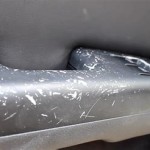How To Clean A Car Interior At Home
Maintaining a clean car interior contributes not only to its aesthetic appeal but also to a healthier and more pleasant driving environment. Regularly cleaning the cabin of a vehicle prevents the build-up of dust, allergens, and other contaminants that can affect air quality and overall comfort. This article provides a comprehensive guide on how to effectively clean a car interior at home, utilizing readily available tools and cleaning solutions.
Preparation and Gathering Supplies
Before initiating the cleaning process, it is crucial to gather all necessary supplies and prepare the vehicle. This initial step ensures efficiency and prevents interruptions once the cleaning has commenced. Essential supplies include a vacuum cleaner with various attachments, microfiber cloths, a soft-bristled brush, interior cleaning solutions (appropriate for different surfaces), glass cleaner, upholstery cleaner (if applicable), a bucket, and a source of clean water. Proper ventilation is also important, so it is recommended to open the car doors or work in a well-ventilated area.
Remove all loose items from the car, such as floor mats, trash, personal belongings, and any other objects cluttering the interior. This step allows for easier access to all surfaces and ensures a more thorough cleaning. Place the floor mats aside for separate cleaning.
A preliminary assessment of the interior condition is beneficial. Identify areas with heavy soiling, stains, or specific types of debris. This allows for targeted cleaning and the selection of appropriate cleaning agents. For instance, leather surfaces require specialized cleaning solutions designed to protect and condition the material.
Vacuuming the Interior
Vacuuming is a fundamental step in cleaning the car interior, effectively removing loose dirt, dust, crumbs, and other debris from carpets, upholstery, and crevices. Start by using a vacuum cleaner with a hose attachment to reach tight spaces, such as between seats, along door panels, and around the dashboard. A crevice tool is particularly useful for accessing narrow gaps and removing embedded particles.
Ensure that the vacuum cleaner has sufficient suction power to effectively lift debris from the carpets and upholstery. For carpets, consider using a brush attachment to agitate the fibers and loosen embedded dirt before vacuuming. Pay close attention to areas that experience high foot traffic, such as the driver's and passenger's side floorboards.
When vacuuming upholstery, use a soft brush attachment to avoid damaging the fabric. Gently vacuum the seats, paying particular attention to seams and crevices where debris tends to accumulate. If the upholstery is heavily soiled, consider using an upholstery cleaner in conjunction with vacuuming, following the manufacturer's instructions for application and removal.
Vacuum the trunk area thoroughly, removing any loose items and paying attention to the spare tire compartment and any storage areas. Many car interiors have hard plastic trim pieces that can be vacuumed as well. Regular vacuuming helps to maintain air quality and prevent the build-up of allergens within the car.
Cleaning Interior Surfaces
Once the interior has been vacuumed, the next step involves cleaning the various surfaces, including the dashboard, door panels, center console, and steering wheel. Use a microfiber cloth dampened with an appropriate interior cleaning solution to wipe down these surfaces. Avoid using harsh chemicals or abrasive cleaners that could damage or discolor the materials.
For the dashboard and other plastic surfaces, use a dedicated interior cleaner specifically formulated for automotive use. These cleaners typically contain agents that help protect the plastic from UV damage and prevent fading or cracking. Spray the cleaning solution onto a microfiber cloth, rather than directly onto the surface, to prevent overspray and potential damage to electronic components.
When cleaning door panels, pay attention to areas that are frequently touched, such as door handles and armrests. These areas tend to accumulate dirt and grime from hands. Use a slightly stronger cleaning solution, if necessary, to remove stubborn stains or residues. Be cautious when cleaning around electronic components, such as window controls and door locks, to avoid accidental damage.
The center console often houses cup holders and storage compartments that can become stained or sticky. Remove any removable inserts or trays and wash them separately with soap and water. Clean the remaining surfaces of the center console with an interior cleaner, paying attention to crevices and corners. The steering wheel, being a high-touch surface, should be cleaned regularly to remove dirt and germs. Use a mild cleaning solution and a microfiber cloth to wipe down the steering wheel, ensuring that it is not left damp, which could cause it to become slippery.
For leather surfaces, use a specialized leather cleaner and conditioner. Apply a small amount of cleaner to a microfiber cloth and gently wipe down the leather surfaces, removing dirt and grime. Follow up with a leather conditioner to help moisturize the leather and prevent cracking or drying. Always test the cleaner and conditioner on an inconspicuous area first to ensure that it does not cause any discoloration or damage.
Cleaning the interior windows and mirrors is essential for maintaining visibility and safety. Use a dedicated automotive glass cleaner and a clean microfiber cloth to wipe down the interior glass surfaces. Spray the glass cleaner onto the cloth, rather than directly onto the glass, to prevent overspray and potential damage to interior components. Wipe the glass in a circular motion, then buff it dry with a clean, dry microfiber cloth to remove streaks and smudges.
For heavily soiled glass, consider using a glass cleaning solution that contains ammonia to help remove stubborn stains or residues. However, use ammonia-based cleaners sparingly and ensure proper ventilation, as ammonia fumes can be irritating. Clean the rearview mirror and side mirrors thoroughly to ensure clear visibility while driving.
Floor mats require specific attention, given the amount of dirt and debris they tend to accumulate. Remove the floor mats from the car and shake them vigorously to remove loose dirt. For carpeted floor mats, vacuum them thoroughly to remove embedded dirt and debris. If the floor mats are heavily soiled or stained, consider using a carpet cleaner or shampoo to deep clean them. Follow the manufacturer's instructions for application and removal, and allow the floor mats to dry completely before reinstalling them in the car. For rubber or plastic floor mats, wash them with soap and water and scrub them with a brush to remove dirt and grime. Rinse the floor mats thoroughly and allow them to dry completely before reinstalling them in the car.
Fabric stain removal is critical, as stains can detract from the overall appearance of the car's interior. Address stains promptly to prevent them from setting and becoming more difficult to remove. Identify the type of stain before attempting to clean it, as different types of stains require different cleaning methods. For example, grease stains may require a solvent-based cleaner, while water-based stains may respond to a simple soap and water solution.
Test any stain remover on an inconspicuous area of the fabric first to ensure that it does not cause any discoloration or damage. Apply the stain remover directly to the stain, following the manufacturer's instructions. Gently blot the stain with a clean microfiber cloth, working from the outside in to prevent the stain from spreading. Avoid rubbing the stain, as this can damage the fabric. Repeat the process as necessary until the stain is removed. Once the stain is removed, clean the area with a damp cloth to remove any remaining residue from the stain remover. Allow the fabric to dry completely before using the car.
Dealing with odors is often necessary in car interiors, especially if the vehicle is frequently used or has been exposed to spills or accidents. Identify the source of the odor before attempting to eliminate it. Common sources of car odors include spilled food or drinks, pet odors, cigarette smoke, and mold or mildew. Once the source of the odor has been identified, take steps to remove or neutralize it.
For spilled food or drinks, clean the affected area thoroughly with soap and water or a specialized carpet or upholstery cleaner. For pet odors, use a pet odor eliminator specifically designed for automotive use. These products typically contain enzymes that break down the molecules responsible for the odor. For cigarette smoke, consider using an air freshener or ozone generator to neutralize the odor. Ozone generators should be used with caution and only in a well-ventilated area, as ozone can be harmful to breathe in high concentrations.
For mold or mildew, address the underlying cause of the moisture problem to prevent it from recurring. Clean the affected area with a mold and mildew cleaner, following the manufacturer's instructions. Ensure that the area is completely dry after cleaning to prevent the mold or mildew from returning. In severe cases of mold or mildew, it may be necessary to consult with a professional detailing service.
:max_bytes(150000):strip_icc()/how-to-clean-car-interior-4775265-Hero-01-e95ef9c85b5343af9c9dadfb87c51f9d.jpg?strip=all)
How To Clean A Car Interior
:max_bytes(150000):strip_icc()/how-to-clean-car-interior-4775265-08-841a91bf649c481a8663348427a23df3.jpg?strip=all)
How To Clean A Car Interior

How To Clean Your Car With Household Items Yourmechanic Advice
:max_bytes(150000):strip_icc()/how-to-clean-car-interior-4775265-05-75df57192f934d70b682febdce167baf.jpg?strip=all)
How To Clean A Car Interior
:max_bytes(150000):strip_icc()/how-to-clean-car-interior-4775265-10-3ae26ac90ed1419dab07ea0b9ec06e8a.jpg?strip=all)
How To Clean A Car Interior

How To Clean Your Car With Household Items Yourmechanic Advice

How To Clean And Disinfect Your Car S Interior At Home

Instructions On How To Clean Your Car Interior Effectively At Home

Clean Your Car Interior At Home Like A Pro Autotrader

How To Clean Cloth Car Seats At Home Without Extractor
Related Posts








